As schools embrace learning management systems designed to make teaching and learning easier, challenges abound. Many educators are struggling to navigate the wealth of tutorials and videos available for Schoology. In this blog entry, the first in the series, we explore three Schoology-related questions. Before we go any further, allow me to share another reason why Schoology has become so pervasive in Texas.
TEA Offers Free Learning Management System
If you missed the July 30, 2020 announcement, you may not have heard that the Texas Education Agency is offering a free LMS in support of the Texas Home Learning initiative. Here’s an excerpt from the announcement:
As part of THL 3.0, TEA announced this week that it will offer all Texas school systems a world-class Learning Management System (LMS) from PowerSchool’s Schoology for two years at no cost. Like other THL 3.0 offerings, use of the Schoology LMS will be optional for Texas school systems. Currently, Schoology is used in schools representing more than one million students across Texas (1 in 5 students statewide).
If you are embarking on your first use of Schoology, this series on LMSs Made Simple will address some key questions teachers are asking.
In This Entry
This first set of questions includes the following:
- How do you keep parents in the loop about missing assignments?
- How do I set up non-graded discussions?
- How do I disable students’ ability to reply to each other?
Ready to get started?
Did You Know?
The Texas Association for the Gifted and Talented (TAGT) is offering a free webinar for parents. The webinar, taking place on Tuesday, September 15, 2020 at 6:30 PM, is Helping Kids Thrive in Today’s World. The speaker is Christine Fonseca. Fill out this form and TAGT will send you a link to the webinar.
Identifying Missing Assignments in Schoology
We know that students may sometimes fail in completing all their assignments on time. One way to motivate them is to make sure parents can access the list of missing assignments. How do you get that done in Schoology? That’s the question Maria is asking below:
Does anyone know a way for teachers to identify missing assignments for the week? A report that shows all weekly assignments and their completion status? Families are having a hard time and I would love a quick way to provide feedback to them. Thanks for all your help.
In Schoology, the teacher can mark assignments as missing in the gradebook. Parents who have signed up can receive updates via email on missing assignments.
Did You Know?
Sign up now for this online, self-paced course that covers everything you need to know about using Schoology and setting up courses. Learn more online.
The first step involves marking student assignments as missing in the gradebook. You can see what that looks like below:
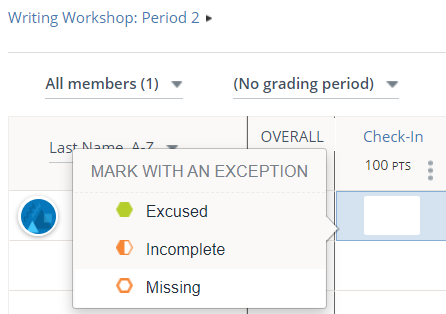
As the teacher, you can export the parent access codes as a comma-separated values (CSV) file. Open this file type in Excel or Google Sheets and then you can email merge it to send to parents. Parents can then sign up via the Schoology website using the access code:
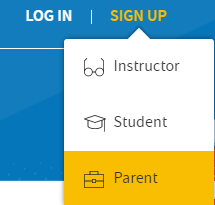
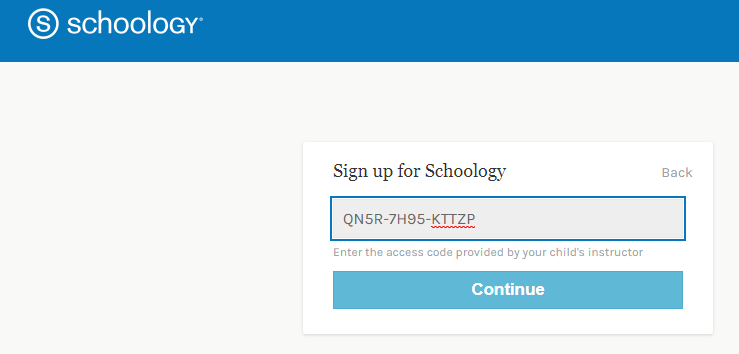
The parent view shows them what assignments are missing or scores/grades received:
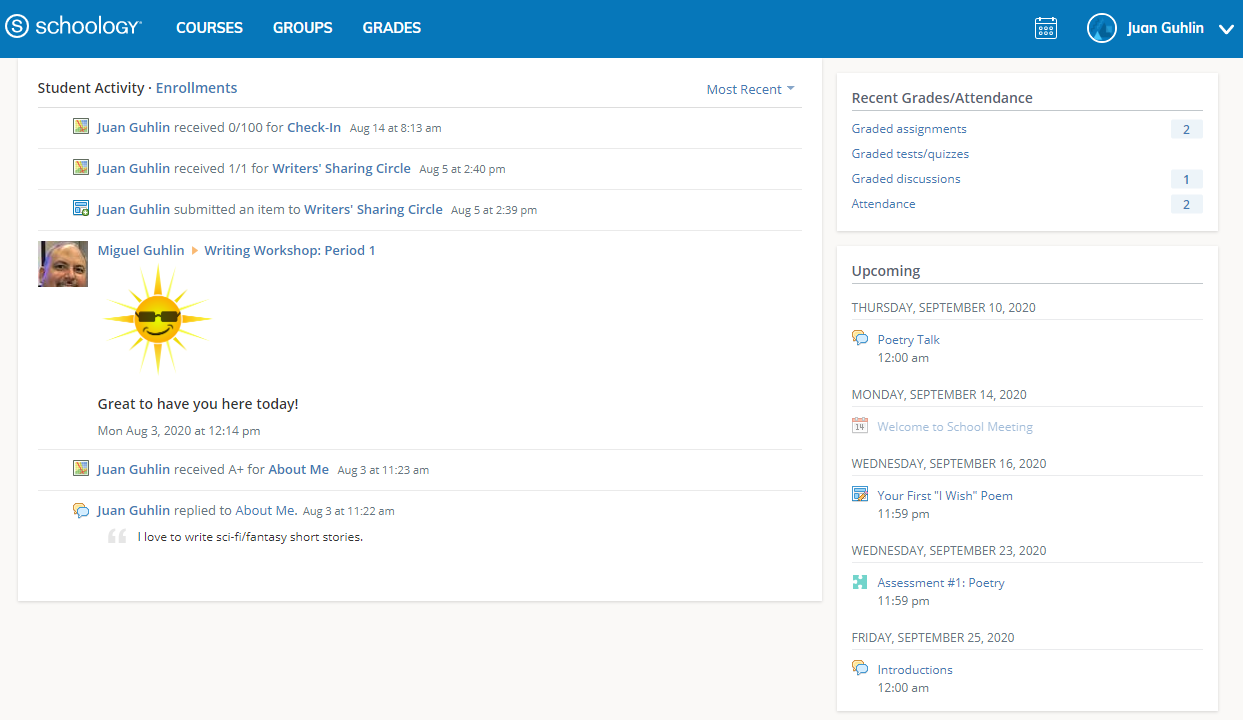
In this way, you’re able to keep parents informed of their child’s progress.
Setting Up Discussions
Setting up discussions in Schoology is straightforward. Let’s take a moment to consider the request Kris shared:
As a K-4 educator, my principal informed me I would be using Schoology this year. As a counselor, I need to set up bibliotheraphy with discussions. I don’t need to grade. What should I do?
Bibliotherapy involves using books as therapy or treatment. School counselors rely on it as a way to treat mental or psychological disorders. As the author of this study points out:
Using quality children’s literature for bibliotherapy helps students to grow socio-emotionally. It assists students in identifying with the main character in a story. That character has a disability which leads to personal insight and growth.
Source: Afolayan J. A. (1992) Documentary perspective of bibliotherapy in education. Reading Horizons 33: 137–148
While reading the book, you can set up activities such as the ones Kelly Bear suggests:
- Ask open-ended questions about the story
- Retell the story
- Act out roles
- Use puppets
- Write reactions
- Record thoughts through audio/video
- Create art
Jumping into Schoology
How will you do this in Schoology in an online environment? One approach can involve using free digital tools like Flipgrid. You can use Flipgrid to create a safe space for student-created book talks. You embed the Flipgrid topic in a Schoology page or discussion topic. Since you can embed content into Schoology pages, assignments, and more, the sky is the limit. You can also encourage students to use Wakelet, Google Docs/Slides, or Microsoft 365. Organize their exploration of a text using one of these tools.
Did You Know?
Sign up for the Remote Learning Tools self-paced course. You’ll pick up a variety of tools that make flipped classroom, hybrid/remote learning easier.
Schoology allows us to set up book-centered folders that may contain relevant resources. What’s more, we can use groups in grading to assign specific students to the bibliotherapy. This means we have to take a few steps though first.
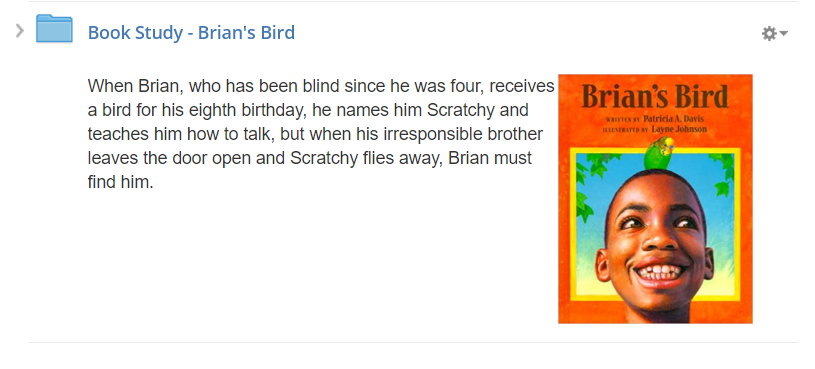
The first step is to get a list of students into the Bibliotherapy course. You have the option of either creating a course for each book (cumbersome) or student, or a course with many books. That is, create the course and then create a “Materials” folder for each book. Then you are able to create pages or discussions that take advantage of grading groups.
Here’s a short video on how to do that in Schoology:
Disabling Students Replying to Each Other’s Posts
Mayra shares a common challenge. At the start of the year, you may want to limit students’ ability to send each other messages. Schoology has an amazing feature known as “Updates.” Google Classroom users have it as well, but for them, it’s the “Stream.” This common feature also appears in Edmodo.
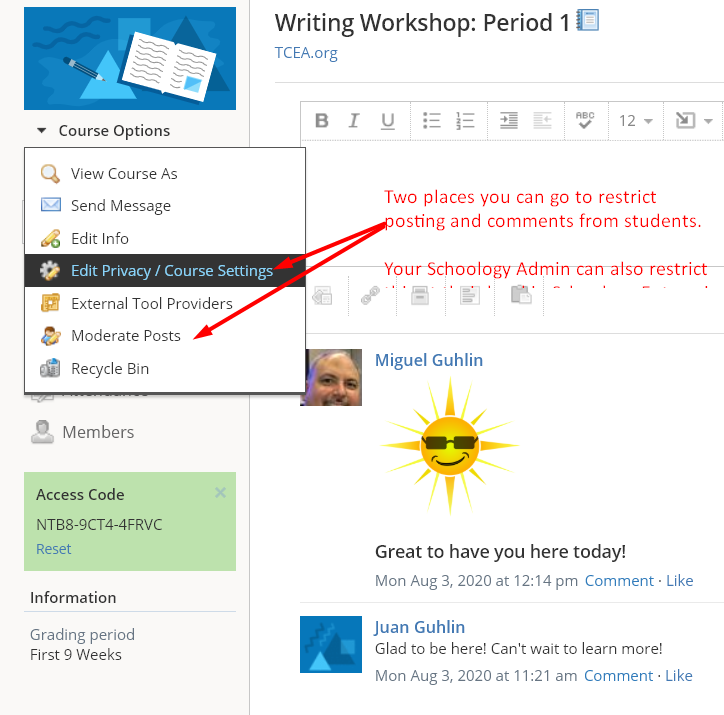
What may not be so obvious is “How do you disable students’ ability to reply to each other’s posts in Schoology?” Some possible responses include:
- Adjust Course Options to turn on moderation or turn that feature off
- Ask your Schoology administrator to disable that and the “liking” feature
- Disable comments for each post
- Set up a discussion that requires students to post first. This means they must post first before they see what others have written.
Since it can be a bit confusing, let’s walk through each of these in a short video.
Hopefully, this first blog in our series was able to answer a question or two you may have about Schoology. In the next installment, we’ll cover some of the ways educators are brightening up their online courses.


2 comments
Admiring the dedication you put into your website and detailed inforrmation you
present. It’s awesome to come across a blog every omce inn a while that isn’t the same outdated rehashed
information. Fantastic read! I’ve saved your site and I’m including your
RSS feeds too my Google account.
Thank you for such a great into to Schoology.